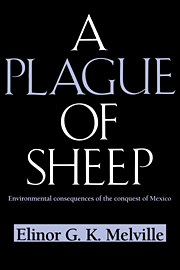Book contents
- Frontmatter
- Contents
- Illustrations and Tables
- Preface
- Chapter 1 Introduction
- Chapter 2 Alien Landscapes
- Chapter 3 The Australian Experience
- Chapter 4 The Mexican Case
- Chapter 5 The Conquest Process
- Chapter 6 The Colonial Regime
- Appendix A Sub-Areas
- Appendix B Population Estimates
- Appendix C Sources for Land Holding and Land Use
- Abbreviations
- Glossary
- Bibliography
- Index
Chapter 4 - The Mexican Case
Published online by Cambridge University Press: 05 August 2012
- Frontmatter
- Contents
- Illustrations and Tables
- Preface
- Chapter 1 Introduction
- Chapter 2 Alien Landscapes
- Chapter 3 The Australian Experience
- Chapter 4 The Mexican Case
- Chapter 5 The Conquest Process
- Chapter 6 The Colonial Regime
- Appendix A Sub-Areas
- Appendix B Population Estimates
- Appendix C Sources for Land Holding and Land Use
- Abbreviations
- Glossary
- Bibliography
- Index
Summary
Human action enormously complicates the picture of environmental change. Even where pastoralism alone is introduced into a lightly populated region, as in New South Wales, manipulation of the environment by humans to achieve the maximum return from their animals combines with the irruptive oscillation to bring about radical, often irreversible changes in the ecosystem. Where the recipient ecosystem already contains dense human populations, and a wide range of activities are introduced along with pastoralism, the processes put in motion are correspondingly more complex. To what extent can we ascribe the erosion events in the Valle del Mezquital to the actions of the pastoralists? If, as I argue, their actions were primary variables in this process, then it should be possible to demonstrate a close correlation between the expansion of intensive pastoralism and deterioration of the environment.
Timing and Intensity of Grazing in the Valle del Mezquital
Differences in timing and degree of exploitation by pastoralism of the sub-areas of the Valle del Mezquital can be demonstrated by two variables:
The area of land formally converted to pastoralism by decade.
The grazing rates for the total area of common pasture by decade, that is, the number of head of sheep per square kilometer on all lands available for grazing.
- Type
- Chapter
- Information
- A Plague of SheepEnvironmental Consequences of the Conquest of Mexico, pp. 78 - 115Publisher: Cambridge University PressPrint publication year: 1994

